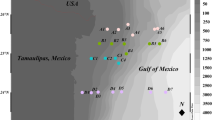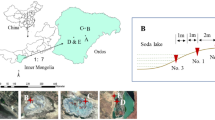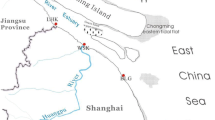Abstract
Sulfate-reducing bacteria (SRB), which obtain energy from dissimilatory sulfate reduction, play a vital role in the carbon and sulfur cycles. The dissimilatory sulfite reductase (Dsr), catalyzing the last step in the sulfate reduction pathway, has been found in all known SRB that have been tested so far. In this study, the diversity of SRB was investigated in the surface sediments from the adjacent area of Changjiang Estuary by PCR amplification, cloning and sequencing of the dissimilatory sulfite reductase beta subunit gene (dsrB). Based on dsrB clone libraries constructed in this study, diversified SRB were found, represented by 173 unique OTUs. Certain cloned sequences were associated with Desulfobacteraceae, Desulfobulbaceae, and a large fraction (60%) of novel sequences that have deeply branched groups in the dsrB tree, indicating that novel SRB inhabit the surface sediments. In addition, correlations of the SRB assemblages with environmental factors were analyzed by the linear model-based redundancy analysis (RDA). The result revealed that temperature, salinity and the content of TOC were most closely correlated with the SRB communities. More information on SRB community was obtained by applying the utility of UniFrac to published dsrB gene sequences from this study and other 9 different kinds of marine environments. The results demonstrated that there were highly similar SRB genotypes in the marine and estuarine sediments, and that geographic positions and environmental factors influenced the SRB community distribution.
Access this article
We’re sorry, something doesn't seem to be working properly.
Please try refreshing the page. If that doesn't work, please contact support so we can address the problem.
Similar content being viewed by others
References
Agrawal, A., and Lal, B., 2009. Rapid detection and quantification of bisulfite reductase genes in oil field samples using real-time PCR. FEMS Microbiology Ecology, 69 (2): 301–312.
Bahr, M., Crump, B. C., Klepac-Ceraj, V., Teske, A., Sogin, M. L., and Hobbie, J. E., 2005. Molecular characterization of sulfate-reducing bacteria in a New England salt marsh. Environmental Microbiology, 7 (8): 1175–1185.
Besaury, L., Ouddane, B., Pavissich, J. P., Dubrulle-Brunaud, C., González, B., and Quillet, L., 2012. Impact of copper on the abundance and diversity of sulfate-reducing prokaryotes in two chilean marine sediments. Marine Pollution Bulletin, 64: 2135–2145.
Biddle, J. F., Cardman, Z., Mendlovitz, H., Albert, D. B., Lloyd, K. G., and Boetius, A., 2012. Anaerobic oxidation of methane at different temperature regimes in Guaymas Basin hydrothermal sediments. The ISME Journal, 6 (5): 1018–1031.
Chang, Y. J., Peacock, A. D., Long, P. E., Stephen, J. R., McKinley, J. P., Macnaughton, S. J., Anwar Hussain, A. K. M., Saxton, A. M., and White, D. C., 2001. Diversity and characterization of sulfate-reducing bacteria in groundwater at a uranium mill tailings site. Applied and Environment Microbiology, 67 (7): 3149–3160.
Colin, Y., Goñi-Urriza, M., Caumette, P., and Guyoneaud, R., 2013. Combination of high throughput cultivation and dsrA sequencing for assessment of sulfate-reducing bacteria diversity in sediments. FEMS Microbiology Ecology, 83 (1): 26–37.
Cottrell, M. T., and Cary, S. C., 1999. Diversity of dissimilatory bisulfite reductase genes of bacteria associated with the deep-sea hydrothermal vent polychaete annelid Alvinella pompejana. Applied and Environment Microbiology, 65 (3): 1127–1132.
de Rezende, J. R., Kjeldsen, K. U., Hubert, C. R., Finster, K., Loy, A., and Jørgensen, B. B., 2012. Dispersal of thermophilic Desulfotomaculum endospores into Baltic Sea sediments over thousands of years. The ISME Journal, 7 (1): 72–84.
Dhillon, A., Teske, A., Dillon, J., Stahl, D. A., and Sogin, M. L., 2003. Molecular characterization of sulfate-reducing bacteria in the Guaymas Basin. Applied and Environment Microbiology, 69 (5): 2765–2772.
Fishbain, S., Dillon, J. G., Gough, H. L., and Stahl, D. A., 2003. Linkage of high rates of sulfate reduction in Yellowstone hot springs to unique sequence types in the dissimilatory sulfate respiration pathway. Applied and Environment Microbiology, 69 (6): 3663–3667.
Foti, M., Sorokin, D. Y., Lomans, B., Mussman, M., Zacharova, E. E., Pimenov, N. V., Kunenen, J. G., and Muyzer, G., 2007. Diversity, activity, and abundance of sulfate-reducing bacteria in saline and hypersaline soda lakes. Applied and Environment Microbiology, 73 (7): 2093–2100.
Fru, E. C., 2011. Microbial evolution of sulphate reduction when lateral gene transfer is geographically restricted. International Journal of Systematic and Evolutionary Microbiology, 61 (7): 1725–1735.
Geets, J., Borremans, B., Diels, L., Springael, D., Vangronsveld, J., Lelie, D., and Vanbroekhoven, K., 2006. DsrB gene-based DGGE for community and diversity surveys of sulfate-reducing bacteria. Journal of Microbiological Methods, 66 (2): 194–205.
He, H., Zhen, Y., Mi, T. Z., Xu, B. C., Wang, G. S., Zhang, Y., and Yu, Z. G., 2015. Community composition and distribution of sulfate-and sulfite-reducing prokaryotes in sediments from the Changjiang estuary and adjacent East China Sea. Estuarine, Coastal and Shelf Science, 165: 75–85.
Jiang, L., Zheng, Y., Peng, X., Zhou, H., Zhang, C., Xiao, X. and Wang, F., 2009. Vertical distribution and diversity of sulfate-reducing prokaryotes in the Pearl River estuarine sediments, Southern China. FEMS Microbiology Ecology, 70 (2): 249–262.
Jørgensen, B. B., 1982. Mineralization of organic matter in the sea bed-the role of sulphate reduction. Nature, 296: 643–645.
Kaneko, R., Hayashi, T., Tanahashi, M., and Naganuma, T., 2007. Phylogenetic diversity and distribution of dissimilatory sulfite reductase genes from deep-sea sediment cores. Marine Biotechnology, 9 (4): 429–436.
Klein, M., Friedrich, M., Roger, A. J., Hugenholtz, P., Fishbain, S., Abicht, H., Blackall, L. L., Stahl, D. A., and Wagner, M., 2001. Multiple lateral transfers of dissimilatory sulfite reductase genes between major lineages of sulfatere-ducing prokaryotes. The Journal of Bacteriology, 183 (20): 6028–6035.
Kondo, R., Mori, Y., and Sakami, T., 2012. Comparison of sulphate-reducing bacterial communities in Japanese fish farm sediments with different levels of organic enrichment. Microbes and Environments, 27 (2): 193–199.
Kondo, R., Nedwell, D. B., Purdy, K. J., and Silva, S. Q., 2004. Detection and enumeration of sulphate-reducing bacteria in estuarine sediments by competitive PCR. Geomicrobiology Journal, 21 (3): 145–157.
Kondo, R., Purdy, K. J., De Queiroz Silva, S., and Nedwell, D. B., 2007. Spatial dynamics of sulphate-reducing bacterial compositions in sediment along a salinity gradient in a UK estuary. Microbes and Environments, 22 (1): 11–19.
Lazar, C. S., Dinasquet, J., L’Haridon, S., Pignet, P., and Toffin, L., 2011. Distribution of anaerobic methane-oxidizing and sulfate-reducing communities in the G11 Nyegga pockmark, Norwegian Sea. Antonie van Leeuwenhoek, 100 (4): 639–653.
Lehours, A. C., Bardot, C., Thenot, A., Debroas, D., and Fonty, G., 2005. Anaerobic microbial communities in Lake Pavin, a unique meromictic lake in France. Applied and Environmental Microbiology, 71 (11): 7389–7400.
Leloup, J., Fossing, H., Kohls, K., Holmkvist, L., Borowski, C., and Jørgensen, B. B., 2009. Sulfate-reducing bacteria in marine sediment (Aarhus Bay, Denmark): Abundance and diversity related to geochemical zonation. Environmental Microbiology, 11 (5): 1278–1291.
Leloup, J., Quillet, L., Berthe, T., and Petit, F., 2005. Diversity of the dsrAB (dissimilatory sulfite reductase) gene sequences retrieved from two contrasting mudflats of the Seine estuary, France. FEMS Microbiology Ecology, 55: 230–238.
Leloup, J., Loy, A., Knab, N. J., Borowski, C., Wagner, M., and Jørgensen, B. B., 2007. Diversity and abundance of sulfatereducing microorganisms in the sulfate and methane zones of a marine sediment, Black Sea. Environmental Microbiology, 9 (1): 131–142.
Lozupone, C., Hamady, M., and Knight, R., 2006. UniFrac-An online tool for comparing microbial community diversity in a phylogenetic context. BMC Bioinformatics, 7 (1): 371.
Madrid, V. M., Aller, R. C., Aller, J. Y., and Chistoserdov, A. Y., 2006. Evidence of the activity of dissimilatory sulfate-reducing prokaryotes in nonsulfidogenic tropical mobile muds. FEMS Microbiology Ecology, 57 (2): 169–181.
Ming, N., Meng, W., and Bo, L., 2009. Effects of salt marsh invasion by Spartina alterniflora on sulfate-reducing bacteria in the Yangtze River estuary, China. Ecological Engineering, 35 (12): 1804–1808.
Minz, D., Flax, J. L., Green, S. J., Muyzer, G., Cohen, Y., Wagner, M., Rittmann, B. E., and Stahl, D. A., 1999. Diversity of sulfate-reducing bacteria in oxic and anoxic regions of a microbial mat characterized by comparative analysis of dissimilatory sulfite reductase genes. Applied and Environment Microbiology, 65 (10): 4666–4671.
Mullins, T. D., Britschgi, T. B., Krest, R. L., and Giovannoni, S. T., 1995. Genetic comparisons reveal the same unknown bacterial lineages in Atlantic and Pacific bacterioplankton communities. Limnology and Oceanography, 40 (1): 148–158.
Mußmann, M., Ishii, K., Rabus, R., and Amann, R., 2005. Diversity and vertical distribution of cultured and uncultured Deltaproteobacteria in an intertidal mud flat of the Wadden Sea. Environment Microbiology, 7 (3): 405–418.
Nakagawa, T., and Fukui, M., 2003. Molecular characterization of community structures and sulfur metabolism within microbial streamers in Japanese hot springs. Applied and Environment Microbiology, 69 (12): 7044–7057.
Nakagawa, T., Nakagawa, S., Inagaki, F., Takai, K., and Horikoshi, K., 2004. Phylogenetic diversity of sulfate-reducing prokaryotes in active deep-sea hydrothermal vent chimney structures. FEMS Microbiology Letters, 232 (2): 145–152.
Pester, M., Knorr, K. H., Friedrich, M. W., Wagner, M., and Loy, A., 2012. Sulfate-reducing microorganisms in wetlandsfameless actors in carbon cycling and climate change. Frontiers in Microbiology, 3 (72): 1–19.
Perez-Jimenez, J. R., and Kerkhof, L. J., 2005. Phylogeography of sulfate-reducing bacteria among disturbed sediments, disclosed by analysis of the dissimilatory sulfite reductase genes (dsrAB). Applied and Environment Microbiology, 71 (2): 1004–1011.
Quillet, L., Besaury, L., Popova, M., Paissé, S., Deloffre, J., and Ouddane, B., 2012. Abundance, diversity and activity of sulfate-reducing prokaryotes in heavy metal-contaminated sediment from a salt marsh in the Medway Estuary (UK). Marine Biotechnology, 14 (3): 363–381.
Rees, G. N., Baldwin, D. S., Watson, G. O., and Hall, K. C., 2010. Sulfide formation in freshwater sediments, by sulfate-reducing microorganisms with diverse tolerance to salt. Science of the Total Environment, 409 (1): 134–139.
Stahl, D. A., Fishbain, S., Klein, M., Baker, B. J., and Wagner, M., 2002. Origins and diversification of sulfate-respiring microorganisms. Antonie Leeuwenhoek, 81 (1-4): 89–195.
Schloss, P. D., Westcott, S. L., Ryabin, T., Hall, J. R., Hartmann, M., Hollister, E. B., Lesniewshi, R. A., Oakley, B. B., Parks., D. H., Roninson, C. J., Sahl, J. W., Thallinger, G. G., Vanhorn, D. J., and Weber, C. F., 2009. Introducing mothur: Opensource, platform-independent, community-supported software for describing and comparing microbial communities. Applied and Environment Microbiology, 75 (23): 7537–7541.
Stackebrandt, E., and Goebel, B. M., 1994. Taxonomic note: A place for DNA-DNA reassociation and 16S rRNA sequence analysis in the present species definition in bacteriology. International Journal of Systematic and Evolutionary Microbiology, 44 (4): 846–849.
Steger, D., Wentrup, C., Braunegger, C., Deevong, P., Hofer, M., Richter, A., Baranyi, C., Pester, M., Wagner, M., and Loy, A., 2011. Microorganisms with novel dissimilatory (bi)sulfite reductase genes are widespread and part of the core microbiota in low-sulfate peatlands. Applied and Environment Microbiology, 77 (4): 1231–1242.
Ter Braak, C. J. F., and Šmilauer, P., 2002. CANOCO Reference Manual and CanoDraw for Windows User’S Guide: Software for Canonical Community Ordination (version 4.5). Microcomputer Power, Ithaca, USA, 500pp.
Teske, A., Hinrichs, K. U., Edgcomb, V., de Vera Gomez, A., Kysela, D., Sylva, S. P., Sogin, M. L., and Jannasch, H. W., 2002. Microbial diversity of hydrothermal sediments in the Guaymas Basin: Evidence for anaerobic methanotrophic communities. Applied and Environment Microbiology, 68 (4): 1994–2007.
Thompson, J. D., Gibson, T. J., Plewniak, F., Jeanmougin, F., and Higgins, D. G., 1997. The clustalX windows interface: Flexible strategies for multiple sequence alignment aided by quality analysis tools. Nucleic Acids Reseach, 25 (24): 4876–4882.
Tian, R. C., Hu, F. X., and Martin, J. M., 1993. Summer nutrientfronts in the Changjiang (Yangtze River) Estuary. Estuarine Coastal and Shelf Science, 37 (1): 27–41.
Wagner, M., Roger, A. J., Flax, J. L., Brusseau, G. A., and Stahl, D. A., 1998. Phylogeny of dissimilatory sulfite reductases supports an early origin of sulfate respiration. Journal of Bacteriology, 180 (11): 2975–2982.
Wayne, L. G., Brenner, D. J., Colwell, R. R., Grimont, A. D., Kandler, O., Krichevsky, M. I., Moore, L. H., Moorf, E. C., Murray, R. G. E., Stackebrandt, E., Starr, M. P., and Truper, H. G., 1987. Report of the ad hoc committee on reconciliation of approaches to bacterial systematics. International Journal of Systematic Bacteriology, 37 (4): 463–464.
Zhang, W., Song, L. S., Ki, J. S., Lau, C. K., Li, X. D., and Qian, P. Y., 2008. Microbial diversity in polluted harbor sediments II: Sulfate-reducing bacterial community assessment using terminal restriction fragment length polymorphism and clone library of dsrAB gene. Estuarine Coastal and Shelf Science, 76 (3): 682–691.
Zverlov, V., Klein, M., Lucker, S., Friedrich, M. W., Kellermann, J., Stahl, D. A., Loy, A., and Wagner, M., 2005. Lateral gene transferof dissimilatory (bi)sulfite reductase revisited. Journal of Bacteriology, 187 (6): 2203–2208.
Author information
Authors and Affiliations
Corresponding author
Rights and permissions
About this article
Cite this article
Zhang, Y., Zhen, Y., Mi, T. et al. Molecular characterization of sulfate-reducing bacteria community in surface sediments from the adjacent area of Changjiang Estuary. J. Ocean Univ. China 15, 107–116 (2016). https://doi.org/10.1007/s11802-016-2781-7
Received:
Revised:
Accepted:
Published:
Issue Date:
DOI: https://doi.org/10.1007/s11802-016-2781-7




